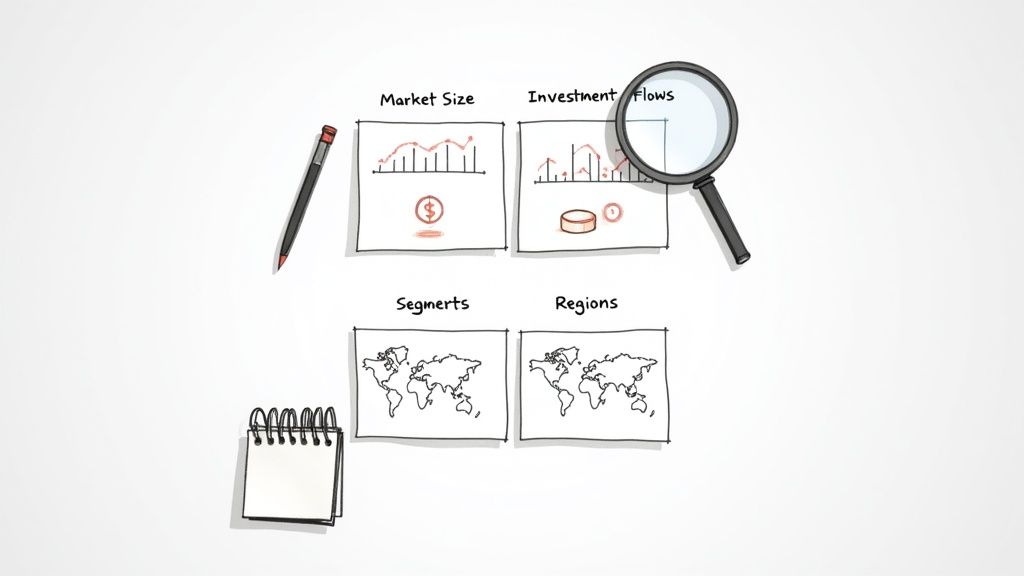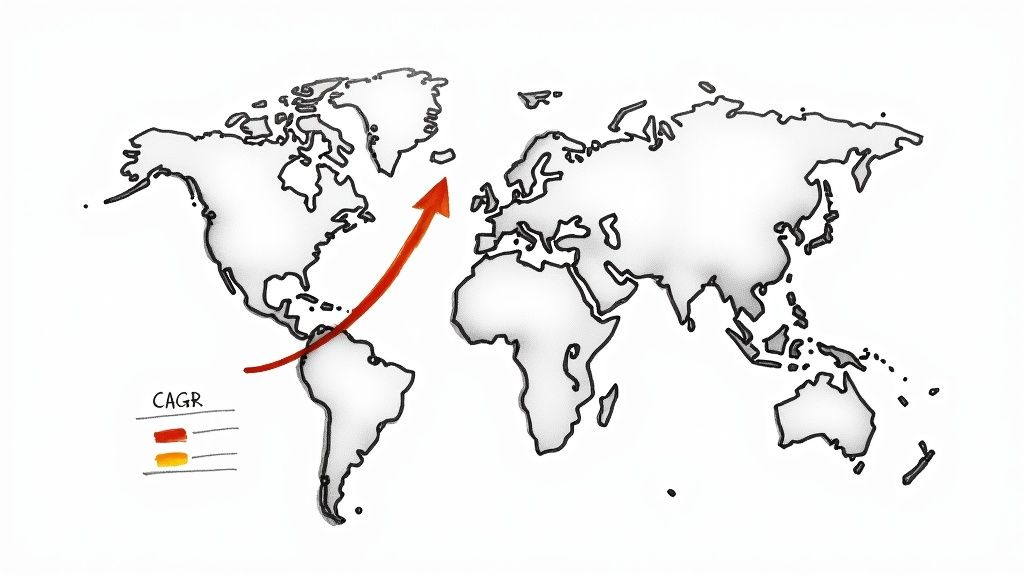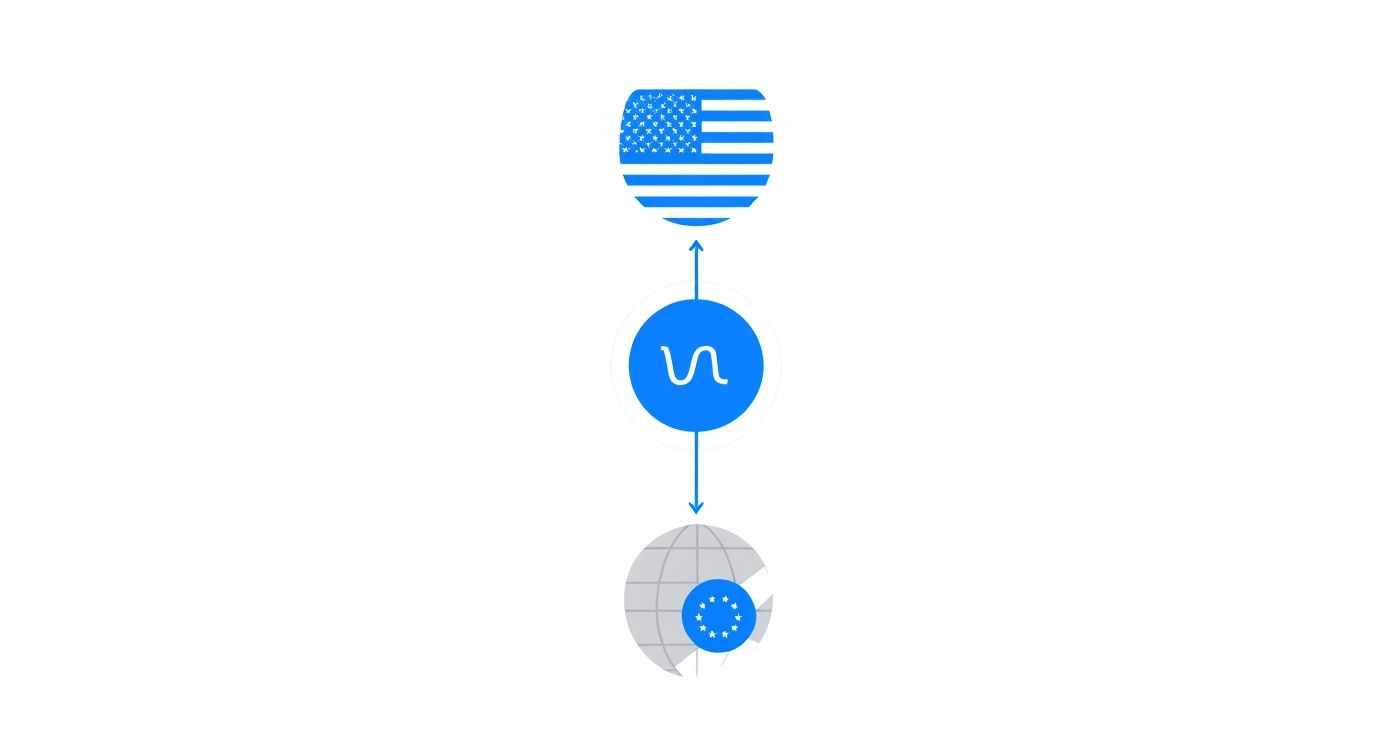An AI overview tracker isn't a product you buy. It’s a system you build. It’s your personal dashboard for monitoring the real signals of the artificial intelligence industry—market size, investment flows, and segment growth—cutting right through the hype.
Most people try to keep up with AI by doom-scrolling headlines. The result? A chaotic mess of hype, confusing news, and billion-dollar valuations that don't mean anything.
The real problem isn't a lack of information. It's the absence of a structured way to make sense of it.
This is why you need an AI overview tracker. It’s a clear, data-driven system to watch the metrics that actually matter. You can finally stop chasing buzzwords and start building a personalized, reality-based view of the market.
First, Build Your Framework (Not a Wishlist)

Think of it like building a dashboard for a race car. You wouldn't just install a speedometer. You need gauges for fuel, engine temperature, and oil pressure. Each one tells a critical part of the story.
Your AI tracker is no different. It needs a few core components to be useful.
- Global Market Expansion: What’s the total size of the AI market and its growth rate? This is your top-line indicator of the industry's health.
- Investment Flows: Where is venture capital and corporate money actually going? Tracking investments reveals which technologies have real momentum.
- Dominant Segments: Which corners of AI are creating the most value? Understanding the difference between machine learning, NLP, and generative AI is critical.
- Regional Power Centers: Where is innovation actually happening? Knowing if North America or Asia-Pacific is leading helps you spot geographic trends.
With this framework, a random news headline becomes an actionable insight. A surge in funding for generative AI in Europe isn't just news; it's a market signal. This same logic can even improve your AI search visibility by showing which topics are capturing attention.
The Goal: Shift from passively consuming AI news to actively analyzing industry signals. Your tracker is the tool that turns raw data into strategic foresight.
Relying on a single source is a bad bet. Analyst firms use different methodologies, leading to different forecasts. A framework forces you to synthesize information, giving you a more reliable perspective. For instance, if one report values the AI market at $244 billion and another at $390 billion, your framework pushes you to ask why. Maybe one includes hardware sales. That's an insight.
Building an AI overview tracker creates a repeatable process to understand a complex industry. It helps you spot trends and make choices based on data, not just speculation.
Gauge the Global Market Expansion
To build an effective AI overview tracker, you need to grasp the market's scale. The global AI market isn't just growing—it's exploding. Nailing down these numbers gives you the context for every other metric you'll watch.

The numbers tell a powerful story. Recent reports peg the global artificial intelligence market around $244 billion, while others push that figure closer to $390.91 billion. This isn't just hype; it's the result of AI shifting from an experiment to a core business tool.
Why Market Valuations Differ
Why the huge gap in estimates? It’s not that one is right and the other is wrong. The difference boils down to what is being measured.
- Scope of Inclusion: Some analyses stick to AI software. Others loop in the hardware that powers it, like GPUs and specialized chips.
- Segment Definitions: A narrow definition might only cover machine learning platforms. A wider one includes everything from chatbots to autonomous cars.
- Geographic Coverage: Reports can also vary based on which regions or emerging markets they include in their final tallies.
A single headline number isn't enough. Your tracker must account for these nuances to paint an accurate picture.
Global AI Market Growth Projections
| Year | Market Value (Low Estimate) | Market Value (High Estimate) | Projected CAGR (Forecast Period) |
|---|---|---|---|
| 2024 | $244.00 Billion | $390.91 Billion | 27.7% (2024-2030) |
| 2030 | $1.35 Trillion | $1.59 Trillion | 30.1% (2023-2032) |
| 2032 | $1.77 Trillion | $2.01 Trillion | 31.5% (2024-2032) |
No matter how you slice it, the trend line points sharply upward. The aggressive growth projections signal strong confidence from investors and enterprises.
The Power of CAGR
One of the most telling metrics for your tracker is the Compound Annual Growth Rate (CAGR). It cuts through short-term market noise and shows you the real long-term momentum.
For the AI market, the projected CAGR hovers between 27.7% and 31.5% for the next decade. That kind of sustained expansion is a clear signal of opportunity. A high CAGR like this tells you that confidence in AI's future is rock-solid.
This consistent double-digit growth is fueled by falling technology costs, massive R&D spending, and a widespread understanding that AI integration is no longer optional.
Example 1: The SaaS Startup Pitch
A B2B logistics SaaS company wants to add AI-powered predictive analytics. They use an AI overview tracker to make their case.
They focus on the high CAGR for the AI services segment, validating their plan to offer AI consulting. They also note that 35% of businesses (according to IBM's 2023 Global AI Adoption Index) have already adopted AI. This data transforms their pitch from a "what if" idea into a data-backed strategic imperative.
Example 2: The Investment Firm's Bet
An investment firm is evaluating two AI startups. One is in the mature machine learning operations (MLOps) space. The other is a newer player in generative AI.
Their tracker shows the total AI market will hit over $1.77 trillion by 2032. But slicing the data, they see generative AI's CAGR is significantly higher than MLOps. This insight helps them weigh the risk-reward profile; the generative AI startup has a much higher growth ceiling. By also monitoring each startup's share of voice, they make a smarter bet.
Map the Regional Power Centers
AI innovation isn't happening everywhere at once. It’s concentrated in key hubs. Keeping tabs on this geographic landscape is a critical part of any AI overview tracker.
North America, powered by the United States, holds a commanding position. This is the result of a perfect storm: a tidal wave of private investment, strong government programs, and the fact that most of the world’s biggest tech companies call it home.
North America: The Current Market Leader
North America has firmly planted its flag as the dominant force, pulling in a huge slice of global revenue. The region's AI market is currently valued at a massive $51.58 billion.
The U.S. alone is the largest single-country AI market, valued at $66.21 billion. (The number is larger than the region's value due to different reporting scopes, but it drives home the country's outsized influence). You can get more details from Grandview Research's AI market report.
The chart below breaks down the U.S. AI market.
Software solutions and machine learning are the main engines, with the Banking, Financial Services, and Insurance (BFSI) sector leading adoption.
The Global Competitors
While North America leads, this race is far from over. Other regions are making strategic moves. Your AI overview tracker needs to watch these rising power centers.
1. Asia-Pacific: The Rapid Challenger The Asia-Pacific (APAC) region is the one to watch. It’s the fastest-growing competitor, with a market valued at $32.89 billion. China boasts an AI industry worth around $34.20 billion, fueled by massive government support. This explosive growth signals that APAC is preparing to challenge North America's top spot.
2. Europe: The Policy-Driven Contender Europe is the third-largest market, with a valuation of €42.6 billion. Europe’s approach is steady and policy-driven, focused on building a sustainable ecosystem around ethical AI. It’s a methodical strategy projected to grow their market to over €190 billion by 2030.
The key takeaway: North America leads today, but the future of AI will be multi-polar. Different regions have different playbooks, meaning the competitive landscape is always shifting.
A smart AI overview tracker doesn’t just look at the global total; it maps these power centers individually to see where the next opportunity will come from.
Decode the Key AI Segments
To build a useful AI overview tracker, you can't just look at "AI" as one giant monolith. The market is a collection of distinct segments. Understanding them is how you spot where the money and momentum are flowing.
Technology Segments: Machine Learning vs. Generative AI
For years, machine learning has been the dominant force—the bedrock for everything from Netflix recommendations to fraud detection.
But generative AI is the explosive new district grabbing all the headlines. It has quickly become one of the fastest-growing segments, pulling in $33.9 billion in global private investment, an 18.7% jump from the previous reporting period, according to the Stanford HAI 2024 report.
While machine learning still holds the largest market share at 36.70%, generative AI is projected to grow at a staggering 22.90% CAGR. For a deeper dive, the full Stanford HAI AI Index report is worth a read. One segment is about stability; the other is pure hyper-growth.
Generative AI is expected to account for 33% of all AI software spending by 2027. This isn't just a trend; it's a fundamental reallocation of enterprise budgets.
Solutions Segments: Software vs. Services
Another way to slice the market is by how AI is delivered.
Right now, software is the biggest piece of the pie, with 51.40% of the market share. Companies are buying ready-to-use AI tools because it's the fastest path to getting capabilities into their workflows.
But watch the services segment. It's set to grow at a solid 18.30% CAGR. A rising services CAGR is a clear signal that companies are moving past simple tools and need specialists to integrate more complex AI systems.
Business Function Segments: Operations vs. Cybersecurity
Where is AI actually being put to work?
The operations segment currently leads with a 21.80% market share. No surprise. Companies are chasing efficiency gains in supply chain management and process automation.
But the real story is in cybersecurity, projected to grow at an impressive 20.40% CAGR. As digital threats get smarter, businesses are scrambling for AI-powered threat detection. This high growth rate points to an urgent need that AI is perfectly positioned to solve.

End-Use Industry Segments: Finance vs. Healthcare
Finally, which industries are all-in on AI?
The Banking, Financial Services, and Insurance (BFSI) sector is the current leader, commanding 19.60% of the market share. They were early adopters, using AI for algorithmic trading and fraud prevention.
But healthcare is catching up fast, projected to expand at a 19.10% CAGR. From diagnostic imaging to personalized treatment plans, healthcare is becoming a massive growth area.
Top AI Market Segments by Growth and Share
This table compares key AI segments, showing where the market share is today and where the growth is headed tomorrow.
| AI Segment | Market Share | Projected CAGR (Forecast Period) | Key Driver |
|---|---|---|---|
| Machine Learning | 36.70% | Lower (Mature) | Widespread, foundational adoption across industries. |
| Generative AI | Lower (Emerging) | 22.90% | Massive investment in content & code generation. |
| Cybersecurity | Lower (Emerging) | 20.40% | Urgent need for advanced, predictive threat detection. |
| Healthcare | Lower (Growing) | 19.10% | Innovation in diagnostics, drug discovery, and care. |
| BFSI | 19.60% | Lower (Mature) | Early adoption in fraud detection and trading. |
The dynamic is clear: while established areas like Machine Learning and BFSI hold the largest shares, the explosive growth is happening in Generative AI, Cybersecurity, and Healthcare.
By dissecting the market like this, your AI overview tracker goes from a simple number to a detailed map.
How to Apply This Framework to Real Decisions
Raw data is a starting point, but it doesn't make decisions for you. The goal is to use that data to answer high-stakes business questions. Here's how it works in the real world.
Case Study 1: The Venture Capitalist
A VC analyst is reviewing a Series A pitch from a generative AI startup. The product looks good, but the valuation is steep. She uses her AI overview tracker to build a data-driven case.
The Situation: A new generative AI company believes it can dominate the Asian market with a specialized LLM for financial services. The team is solid, but the investment committee is nervous about regional competition.
Applying the Tracker:
- Validate the Hype: The tracker shows generative AI pulled in $33.9 billion in global private investment and will make up 33% of all AI software spending by 2027. This confirms the segment's explosive growth and justifies the high valuation potential. It’s a hot market, not just hype.
- Zero in on the Region: The data reveals the Asia-Pacific AI market is valued at $32.89 billion and is the fastest-growing region. This flips the script, turning a perceived weakness into a calculated strength.
- Find the Money: She cross-references the industry data. The BFSI sector is the leader in AI adoption, commanding a 19.60% market share. This tells her the startup is targeting a mature, well-funded customer base.
The Outcome: The analyst argues the startup sits at the intersection of three massive trends: a booming technology (generative AI), a high-momentum geography (Asia-Pacific), and a top-spending industry (BFSI). The committee approves the deal.
Case Study 2: The Product Manager
A Product Manager (PM) at a B2B software company needs to build a business case for a pivot into AI-powered cybersecurity.
The Situation: The company’s flagship product has flat growth. A move into AI cybersecurity could be the answer, but it's a huge investment. The PM needs data to convince stakeholders.
Applying the Tracker:
- Find the Pain: The tracker shows the cybersecurity segment is set to explode with a 20.40% CAGR. This signals escalating, high-priority pain among potential customers.
- Define the Solution: Software commands 51.40% of the market. This shows a strong customer preference for scalable products over custom services, shaping the business model.
- Map the Territory: The PM narrows the focus to North America. The tracker shows this market is valued at $51.58 billion. The sheer size of the opportunity validates focusing resources there first.
The Outcome: The PM presents the business case backed by market data. The leadership team sees a clear opportunity defined by high growth, a proven solution model, and a massive addressable market. The project gets the green light.
An AI overview tracker is a tool for making smarter, faster, and more confident decisions. To sharpen your own strategy, check out these other AI tools for competitive analysis.
Your Next Steps: From Analysis to Action
Building an AI overview tracker isn't about passively collecting data. The point is to turn insights into a competitive edge.
A Simple Three-Step Tracking Habit
- Isolate Core Metrics: Focus only on numbers that impact your business—market size, specific segment growth rates, or key regional shifts.
- Identify Credible Sources: Pick a handful of reliable, high-signal data sources. Consistency is more valuable than trying to consume everything.
- Schedule Regular Reviews: Block out time weekly or monthly to update your tracker and think. Your goal isn't just to enter data; it's to connect the dots and spot emerging patterns.
This structured approach transforms raw numbers into genuine strategic foresight. You start seeing the field with a clarity most competitors lack. As a side benefit, you'll improve your gut instinct for how to rank in Google SGE by seeing which topics are gaining traction in real-time.
Common Questions (And Straight Answers)
Here are a few common questions I get, along with some no-nonsense answers.
How often should I update my AI tracker?
It depends. For high-level strategic planning, a monthly review is plenty. It helps you see major trends without getting lost in daily noise.
But if you're a VC or product manager in a fast-moving space, check it weekly at minimum. That's how you spot a competitor's funding round or product launch the moment it happens. Just don't fall into the daily update trap—that's a great way to get a lot of noise and very little signal.
What are the most reliable sources for AI market data?
There's no single magic source. The goal is to blend data from several credible places to get the full picture.
Your best bet is to combine reports from big market research firms (like Grandview), data from university labs (like the Stanford HAI), and numbers from financial terminals that track private investments.
This approach gives you a much more balanced view than relying on one report. It lets you see where everyone agrees and spot the interesting outliers.
Can I use this framework to track a specific AI niche?
Absolutely. In fact, that's where it becomes most powerful. The core pillars—tracking market size, investment, key players, and segments—are universal. You just narrow your focus.
Let's say you want to track "AI in healthcare diagnostics":
- Market Size: You'd ignore the broad AI market and zoom in only on the healthcare segment's valuation and CAGR.
- Investment: You'd track funding rounds for startups specifically in that diagnostic space.
- Segments: You'd break it down further into sub-niches like radiology AI versus pathology AI.
- Players: You'd monitor the top three companies in diagnostic AI, not all of Big Tech.
This is what makes the tracker actionable.
What’s the biggest mistake to avoid when analyzing AI trends?
Easy. The biggest mistake is confusing correlation with causation. It's tempting to connect dots that aren't really there. Just because generative AI investment is up and a competitor's revenue jumped doesn't mean one caused the other.
Always look for direct evidence. Did that competitor launch a new gen AI product that directly accounts for the revenue spike? Or did they just hire a killer sales team? Force yourself to find the "why" behind the numbers in your AI overview tracker.
Ready to stop guessing where your brand stands in the new AI-driven search landscape? With AI SEO Tracker, you can see exactly where your brand appears in LLM answers across ChatGPT, Gemini, and more. Get a demo to discover the high-intent prompts your customers are using and build a data-backed plan to win them. Visit https://aiseotracker.com to learn more.

